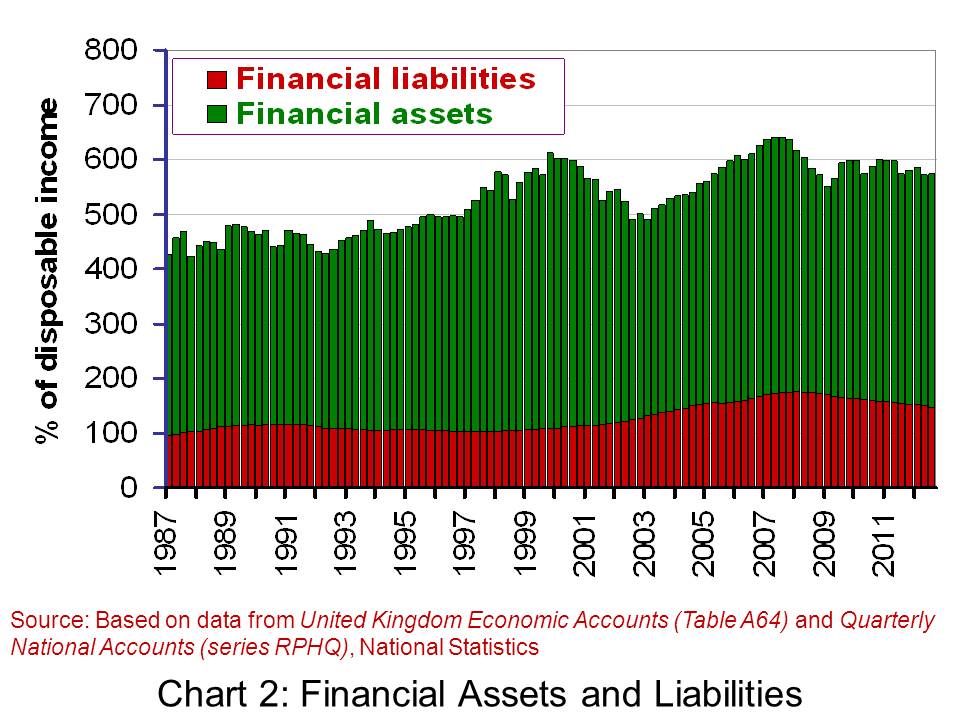We can also see from the table the significance of the value of non-financial assets to net worth. The value of households’ physical wealth is slightly larger than the value of its financial assets, though in 2011 both equate to around 4¼ times the annual flow of disposable income.
2011 saw the value of the stock of non-financial wealth grow by 0.7 per cent while the value of the sector’s stock of financial assets fell by 0.4 per cent. Meanwhile, the value of the stock of financial liabilities was virtually unchanged at a little over £1½ trillion. In 2011, the sector’s financial liabilities were equivalent to around 1½ times its annual disposable income. While this is down from the 2007 peak of 1¾ times income, it is considerably higher than during the period from 1987 to 1999 when the financial liabilities to income ratio remained consistently close to 1. The 2000s saw a rapid expansion of the sector’s liabilities relative to its income and, hence, today there remains what economists call a debt overhang.
Despite the very small overall increase in net worth in 2011, the stock of net wealth was up by 18 per cent on 2008. During 2008, net worth fell by 12 per cent. This was on the back of a fall in non-financial wealth of 9.4 per cent, a fall in the value of financial assets of 10.1 per cent and an increase in the value of financial liabilities of 1.9 per cent.
Chart 1 gives an historical picture of net worth. It shows the two principal balances that comprise net worth: net financial wealth and physical wealth. Each is shown relative to annual disposable income. Again, we can see the importance of physical wealth to overall net worth. The growth in house prices from the late 1990s through to the economic downturn of the late 2000s helps to explain its rising relative importance in net worth. We can also see from the chart that the relative level of net worth is roughly on a par with its value at the end of the 1990s. However, the composition is different. Today, relatively more of the sector’s net worth comes from non-financial wealth compared with that from net financial wealth.
A crucial question for spending in the months ahead is how inclined the household sector feels to consolidate its balance sheets further.  Chart 2 includes more recently available data on financial assets and liabilities from United Kingdom Economic Accounts, Q3 2012. From it we can see the declining stock of financial liabilities relative to disposable income. This has been driven by an actual fall in the stock of unsecured financial liabilities. In the 12-month period up to the end of Q3 2012, the stock of unsecured financial liabilities fell by 6.4 per cent (the stock of secured debt rose by 1.8 per cent). This consolidation of unsecured debt suggests that households remain understandably cautious given the uncertain economic environment. Hence, the household balance sheet will most probably continue to constrain consumption growth in the short-term.
Chart 2 includes more recently available data on financial assets and liabilities from United Kingdom Economic Accounts, Q3 2012. From it we can see the declining stock of financial liabilities relative to disposable income. This has been driven by an actual fall in the stock of unsecured financial liabilities. In the 12-month period up to the end of Q3 2012, the stock of unsecured financial liabilities fell by 6.4 per cent (the stock of secured debt rose by 1.8 per cent). This consolidation of unsecured debt suggests that households remain understandably cautious given the uncertain economic environment. Hence, the household balance sheet will most probably continue to constrain consumption growth in the short-term.
In Gloomy prospects for UK consumer spending in 2012? we talked about how consumer spending can be affected by the financial position of households. Figures from United Kingdom National Accounts – Blue Book 2011 (see Tables 6.1.9 and 10.10) give the latest complete set of balance sheets for the UK household sector. The figures are for 2010 and in this blog we provide a brief overview of what these figures reveal.
In effect, there are two main balance sheets of interest for households (and non-profit institutions serving households (NPISHs), i.e. charities and voluntary organisations). The first details their net financial wealth and the second their physical wealth, also known as their non-financial wealth. We begin with net financial wealth. This is found by subtracting financial liabilities (debt) from financial assets. The household sector in 2010 had financial liabilities of £1.54 trillion equivalent to 1.6 times its disposable income for the year or 1.1 times the nation’s Gross Domestic Product. Of these liabilities, £1.2 trillion was mortgage debt, i.e. loans secured against property. On the other hand, the sector had financial assets of £4.3 trillion equivalent to 4.4 times its disposable income in 2010 or 3 times GDP. Of these financial assets, the value in pension funds and life assurance was £2.27 trillion.
The net financial wealth of households and NPISHs in 2010 was £2.8 trillion, 2.9 times the sector’s disposable income for the year or 1.9 times GDP. To this we need to add physical wealth of £4.9 trillion, a massive 5 times the sector’s disposable income or 3.3 times the nation’s GDP. The majority of this is residential buildings the value of which were put at £4 billion for 2010. This demonstrates the significance of housing to the UK household sector balance sheet.
If we now add physical wealth to net financial wealth, we find that in 2010 the household and NPISH sector had a net worth of £7.7 trillion. To put this in context, it is equivalent to 7.8 times the disposable income it earned in 2010 and 5.3 times the UK’s Gross Domestic Product. While these are enormous figures it is worth noting that in 2007 the sector’s net worth was £7.4 trillion, equivalent to 8.5 times annual disposable income.
A trawl through the figures clearly shows the impact of the financial crisis on the sector’s net worth. From £7.4 trillion in 2007, net worth fell in 2008 to £6.6 trillion or 7.2 times annual disposable income. However, 2009 and 2010 did see the households’ net worth increase again – including relative to its disposable income. This has been the result of its net financial wealth increasing. Net financial wealth in 2010 was 9.8 per cent higher than in 2007. However, the depressed housing market has continued to adversely impact on the sector’s net worth. Physical wealth in 2010 was 0.7 per cent lower than in 2007.
Of course, while these empirical observations are undoubtedly interesting, the key question for debate is how these patterns affect household behaviour. Of particular importance, is how changes in both the household sector’s total net worth and the components making up the total will translate into changes in consumer spending. Economists are increasingly recognising that in understanding consumer spending patterns we need to gain a deeper understanding of the impact of the balance sheets on consumer spending. It is quite likely that many retailers when forming their plans for the year ahead will be analysing the potential impact of household finances on spending behaviour. Developing strategies to respond to the state of the household balance sheets may be crucial to their success.
Data
United Kingdom National Accounts – Blue Book 2011 (datasets) Office for National Statistics (see Tables 6.1.9 and 10.10)
Articles
Debt levels head towards £30,000 for every adult Mirror, Tricia Phillips (2/12/11)
40% risk getting further in debt this Christmas Independent, Simon Read (3/12/11)
Uk’s debts ‘biggest in the world’ BBC News, Robert Peston (21/11/11) (This article looks at debt across all sectors, including corporate and government debt too)
Drowning in debt: Warning over 4,000% interest rates as 3.5m people say they will be forced to take out ‘payday’ loans in the next 6 months Daily Mail, Emily Allen (7/12/11)
UK households wealthier than Germany’s says UBS Telegraph, Jamie Dunkley (9/12/11)
Questions
- In the context of the household balance sheets, explain the difference between the concepts of stocks and flows.
- Illustrate with examples your understanding of what is meant by secured and unsecured debt. What factors are likely to affect the growth from one period to another in the stocks of secured and unsecured debt outstanding?
- Draw up a list of possible factors that could affect the value of the household sector’s net financial wealth. Now repeat the exercise for non-financial wealth.
- Draw up a list of ways in which you think changes to the values of items on the household balance sheets could affect consumer spending. After drawing up this list consider their significance in 2012.
- What sort of items would be included in the balance sheets of firms and of government?
 Consumer spending is crucial to an economy. In the UK total consumer spending is equivalent to almost two-thirds of the value of country’s GDP. Understanding its determinants is therefore crucial in attempting to forecast the short-term path of the economy. In other words, the growth of the economy in 2013 will depend on our inclination to spend.
Consumer spending is crucial to an economy. In the UK total consumer spending is equivalent to almost two-thirds of the value of country’s GDP. Understanding its determinants is therefore crucial in attempting to forecast the short-term path of the economy. In other words, the growth of the economy in 2013 will depend on our inclination to spend.
